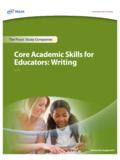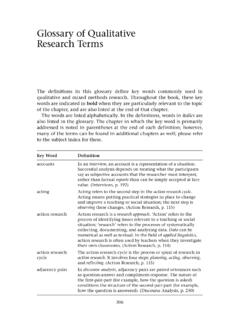Transcription of Key Terminology for analysis of texts How to approach ...
1 AQA GCSE GUIDE English Language Revision Guide What you will need to know: Key Terminology for analysis of texts How to approach Unseen Language extracts How to analyse How to Compare How to write creatively How to write accurately How to write with flair, engagingly and interestingly How to write for a specific Purpose, Audience & Format &. Tone (NON-FICTION WRITING). English AQA Language and Literature GCSE at a glance guide You will achieve 2 GCSEs in English. You have no coursework. Everything you learn over the two years will be assessed by exams at the end of the two years.
2 Paper One Reading Section A Writing Section B. Language 1 hour 45 minutes One fiction text to read One fiction writing task -Creative writing in total (extract from a piece of 20th 24 marks for communication 16 marks for technical Century Literature) accuracy (40 marks). 50% of the 4 questions to answer language GCSE 1 brief answer x 4 marks 2 x 8 marks 1 x 20 marks (40 marks). Paper Two Reading Section A Writing Section B. Language 1 hour 45 minutes Two linked non-fiction texts One non-fiction writing tasks ( , write a letter, to read report, interview etc for a specific purpose, audience and in total format).
3 4 questions to answer: 80 marks 1 multiple choice x 4 marks 24 marks for communication 16 marks for technical 50% of the 1 x 8 marks accuracy (40 marks). 1x 12 marks Language GCSE 1 x 16 marks (40 marks). Paper One Section A Shakespeare Section B 19th Century Text Literature 1 hour 45 minutes Shakespeare: 19th Century Text: Extract bringing in whole play Extract bringing in knowledge of whole text 64 marks in total One Question knowledge 40% of the 20% of the GCSE. One Question Literature exam 20% of the GCSE. Paper Two Section A: Modern Section B: Section C: Unseen Literature Prose or Drama Text Poetry Poetry 20%.
4 Anthology 2 hours 15 One question on the text studied Comparative question: Two previously unseen poems Closed book exam (no copies One copy of a poem Two questions minutes allowed in the exam) from the anthology in Question one: Essay on poem 96 marks One question exam to compare with one another example from Question two: Comparative 60% of overall the anthology but essay on poem one and the Literature GCSE unseen in the exam. second unseen poem One question Writer's Techniques **Alliteration: a series of words in a row which have the same first consonant sound.
5 **. Assonance: repetition of vowel sounds. Allegory: extended metaphor in which a symbolic story is told Anecdote: a short story using examples to support ideas Bias: inclination or prejudice for or against one person or group, especially in a way considered to be unfair Clich : overused phrase or theme Consonance: repetition of consonant sounds, most commonly within a short passage of verse Caesura: a break in the middle of a line of poem which uses punctuation (any . , : ; etc ). **Connotations: implied or suggested meanings of words or phrases**.
6 **Dialogue: speech**. **Directive: using you we or use**. **Ellipsis: using 3 dots as punctuation to express emotion or that something has been omitted from the writing**. Enjambment: incomplete sentences at the end of lines in poetry End-Stopping: punctuation at the end of a line of poetry **Emotive Language: language which creates an emotion in the reader**. **Exclamation mark: ! punctuation used to express surprise, shock, shouting etc.**. Extended Metaphor: a metaphor that continues into the sentence that follows or throughout the text **Facts: information that can be proven**.
7 **First Person: using I to tell the story**. **Humour: Provoking laughter and providing amusement**. **Hyperbole: use of exaggerated terms for emphasis**. **Imagery: creating a picture in the readers head**. Juxtaposition: placing contrasting ideas close together in a text **Metaphor: a comparison as if a thing is something else**. Motif: a recurring set of words/phrases or imagery for effect Onomatopoeia: words that sound like their meaning **Opinion: information that you can't prove**. Oxymoron: using two terms together, that normally contradict each other Pathetic Fallacy: ascribing human conduct and feelings to nature Protagonist: the main character who propels the action forward **Personification: giving human qualities to inanimate objects, animals, or natural phenomena**.
8 **Repetition: when words or phrases are used more than once in a piece of writing**. **Rhetorical question: asking a question as a way of asserting something. Asking a question which already has the answer hidden in it.**. Sibilance: repetition of letter 's', it is a form of alliteration Second Person: using you' to tell a story Superlative: declaring something the best within its class the ugliest, the most precious Sensory detail imagery: sight, sound, taste, touch, smell **Simile: comparison between two things using like or as**.
9 **Statistics: facts and figures**. Symbolism: the use of symbols to represent ideas or qualities **Third Person: using he, she it & they' to tell the story**. Tense: writing which is in the past, present or future Triplets: repetition of three ideas, words or phrases close together **Tone: the way a piece of text sounds sarcastic etc.**. Sentence Structure information Sentence structures: simple a short sentence which uses capital letter at the start and full stop at the end and has only one clause in it. Compound two clauses joined by a connective (use the FANBOYS acronym), A complex sentence contains one independent clause and at least one dependent clause.
10 Unlike a compound sentence, however, a complex sentence contains clauses which are not equal. Complex sentences are sometimes called a three part sentence and often use a variety of sentence openings (use the PANIC acronym). Clause: a clause is one independent idea which forms part of a sentence Word Class analysis **Adjective: a word used to describe**. **Adverb often ly words which describes how things are done**. **Modal verbs: verbs which offer a choice could, should will etc.**. **Connotations: implied or suggested meanings of words or phrases**.









